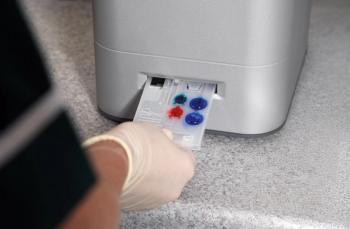
Perfect the veterinary practice flow: traffic, technology, and talk
Find out how Drs. Alan Green and David Sachs of Charleston Veterinary Referral Center built a big hospital with little room for confusion in Charleston, S.C.
Dr. Alan Green wanted the doctors, staff members, and clients to know where to find each and every veterinary service offered in his 16,345-square-foot hospital—without a map. So when the time came to build Charleston Veterinary Referral Center in Charleston, S.C., he wanted to get the traffic flow just right.
“Hallways are our enemy. I just hate walking into a practice and being confused as to where to go,” says Dr. Green, co-owner of the hospital.
The public zone of the clinic is built in a horseshoe shape, with 10 exam rooms looping the reception desk, check-in and check-out areas, and administrative office. This simple design helps clients navigate the not-so-small practice. And it helped the referral center win a 2012 Veterinary Economics Hospital Design Competition Merit Award.
The judges loved the separate check-in, check-out, and discharge areas and the improvement to traffic flow these features afford. When clients arrive, they check in at the front desk as usual. Behind the front desk sits a separate phone reception area and immediately behind that space is check-out. Across from check-out is a discharge alcove, a semi-private area that allows doctors or technicians to sit down with a client and review and discuss discharge information in an unhurried, relaxed atmosphere.
Photos by MJ Green
Another little touch that Dr. Green says makes his hospital special—and more convenient for clients—is a private part of the reception area. This space, just behind the triage room and steps from the reception desk, welcomes clients who need to get away for any reason.
“We have a lot of clients who drive a long way for chemotherapy appointments. This space gives them a quiet place to rest, work, or take a break away from the busier reception area,” he says. “Grieving clients also make use of this private space. This is one touch that’s really been a home run.”
To keep emergency traffic to a minimum, Dr. Green designed a triage exam room steps from the entryway. “We wanted to give clients a bit of privacy without having to walk all the way to the treatment area,” Dr. Green says. “We keep the room stocked for minor emergencies, and when we’re busy we staff a dedicated emergency technician in this room.”
This “ideal” floor plan came from Dr. Green’s experience as a private practitioner and an emergency/referral veterinarian; his partner, Dr. David Sachs; and the experience of his staff members, architect, and local contractor. Plus, Dr. Green’s wife, MJ, orchestrated the hospital’s interior and logo design.
“The collaboration made for an incredible outcome,” Dr. Green says. “The project was initiated summer 2010, construction began October 2010, and we opened our doors February 28, 2011.”
Before the team opened the doors, however, they enhanced communication in the clinic. Hollering across the room to get a staff member’s attention would not do in a 16,000-square-foot hospital.
To facilitate greater communication between referral doctors and general practitioners, they use a practitioner portal to update records. General practitioners log in to view their patients’ records as well as digital radiographs. The practice employs board-certified dental specialists who use digital radiography as a matter of course, and this technology allows them to do a better job of diagnosing, treating, and communicating results.
“Part of our mission is to make our practice feel like an extension of a doctor’s general practice,” Dr. Green says. “Of course, if you’re going to delve into technologies, it helps to have young, smart, tech savvy members on board.”
He gives all technology kudos to Dr. Sachs and team member Michael Parks, LVT. He says they spent hours researching practice software, practitioner portals, time-stamped census boards, and other systems to streamline practices.
The flow of communication also includes referral letters sent via fax the minute they’re written to referring doctors. A time-stamped census board helps Dr. Green and his team see where clients and patients spend their time—and allows them to make tweaks to their approach to adjust as needed. Visit
Dr. Green says a great floor plan and high-quality technology help the best veterinary practitioners offer the best care to patients.
Charleston Veterinary Referral Center
3484 Shelby Ray Court, Charleston, SC 29414
(843) 614-8387 Fax (843) 614-8722
Owners: Drs. Alan Green and David Sachs
Associates: 15
Hospital team: 47
Practice type: Small animal specialty referral
and emergency
Building size: 16,345 square feet
Runs: 6 hospital indoor
Exams: 10
Cages: 50
Parking spaces: 25 client and 25 staff
Construction: $2.2 million (building only, excludes land purchase, landscaping,
parking lot, etc.)
Site improvement: $96,942
Professional fees: $145,000
Equipment: $1.1 million
Furnishings: $50,000
Computers: $105,000
Year built: 2011
Architects:
Paul Gladyzs, Wendy Wheeler Martinez
Gladysz & Usiak Architecture
901 Lamberton Place, NE, Albuquerque, NM 87107
(505) 858-0180 • fax (505) 858-0111
Reception
Storefront doors lead straight to the tiled reception desk for immediate access. Administrative services sit just behind the reception desk but are screened from public view. A large painted mural welcomes clients into the main reception area—visit
Triage exam room
The triage exam room sits immediately adjacent to the reception area. This room, fully stocked for minor emergencies, minimizes steps for critical patients and worried pet owners. During busy times, a triage technician staffs this room.
Treatment
Dr. Green chose to leave this area wide open to keep the traffic flow moving and team members visually connected. Above a cage bank open to the main treatment area are two large monitors—instead of whiteboards—for keeping track of patients.
Pharmacy
Surgery
The hospital features three surgery suites with pass-through cabinets into the first two suites. One surgical suite offers natural light provided from an existing exterior window.
Private lobby
This peaceful space offers clients with a long wait a quiet place to rest or grieve. A stocked coffee bar, mini refrigerator, couch, TV, and magazines make the wait more comfortable. A desk in the corner offers space for a laptop for those who need to catch up on work.
Newsletter
From exam room tips to practice management insights, get trusted veterinary news delivered straight to your inbox—subscribe to dvm360.




